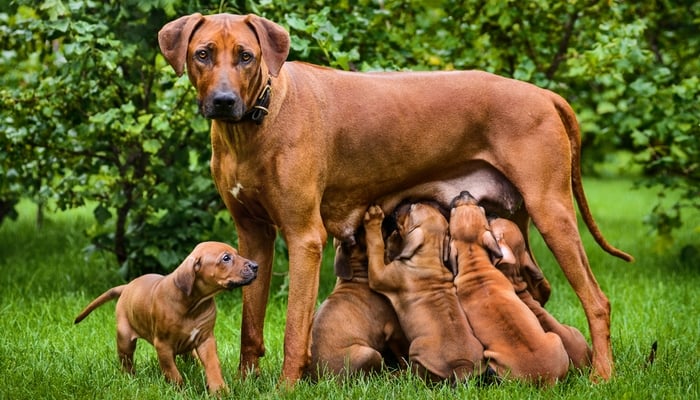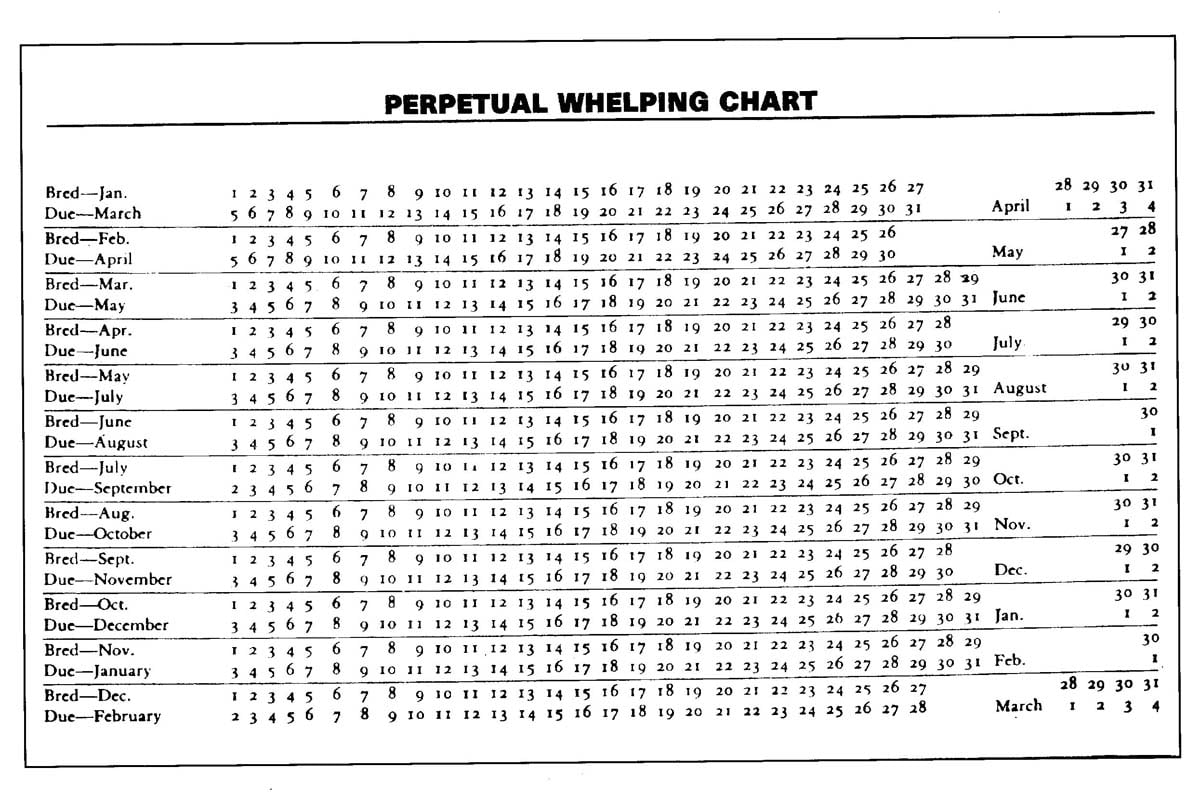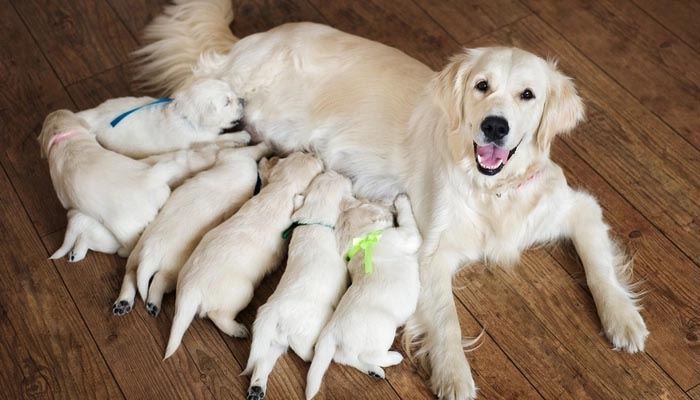
Table of Contents
Many first-time dog owners are wondering about dog pregnancy.
If you think your dog is pregnant, hopefully, it was a planned event.
If it was, then you've already done your research and know what to expect over the next few months.
In the case that the pregnancy was a surprise, you may be wondering how long dogs stay pregnant and what else you need to know about the process.
This article will discuss everything about pregnant dogs and what dog owners must know.
This dog pregnancy guide will provide you with advice and information on the following:
- When, how, and how often dogs ovulate and get pregnant;
- How long do dogs stay pregnant (dog gestation period), and what is the size of litters;
- How to feed a pregnant dog and what nutrition she requires;
- Best dog food for a pregnant dog and what to avoid;
- Signs of labor and how to prepare to deliver puppies;
- Potential complications during pregnancy and how to avoid them.
As someone who's already been through the process of caring for a pregnant dog twice, I can provide some good pointers to pet parents of pregnant female dogs and answer the most common questions.
However, if your female dog is pregnant, you still need to get her in to see a veterinarian as soon as possible.
Your vet will walk you through the stages of canine pregnancy and give you advice on the type of diet a pregnant dog should be eating.
The vet will also assess how far along your dog is in her pregnancy and explain how long do dog stay pregnant.
Resources on Dog Pregnancy
If you need more resources than the below canine pregnancy guide, I recommend reading one of the more popular dog pregnancy books that will prepare you for this endeavor.
You will learn about the canine whelping process and everything related, including potential risks and problems.
 My favorite is Dog Breeding, Whelping, and Puppy Care book, which was the most extensive material, but a few others are below.
My favorite is Dog Breeding, Whelping, and Puppy Care book, which was the most extensive material, but a few others are below.
- Advanced Canine Reproduction and Puppy Care by Myra Savant Harris
- The Layman's Guide to Whelping Puppies by Karen j Cornwell
- Raising Your First Litter of Puppies by Eleanor Green Winters
- The Complete Book of Dog Breeding by Dan Rice, DVM
There will be some tests you need to be aware of; they are done on pregnant dogs that are expecting puppies, and your vet will let you know whether or not your pooch will need them.
Dog pregnancy is an exciting time, but it's also something that needs to be taken seriously.
Like with humans, the health of newborn puppies directly depends on the health of their mother, so you'll need to be sure to give her top-notch prenatal care.
RELATED: How Long Are Dogs Pregnant?
Dog Pregnancy Questions Answered
How Often Can a Dog Get Pregnant?
A female dog comes into heat approximately once every 6 months, beginning at an average age of six months old. This cycle can vary, however.
For example, some larger breed dogs only come into heat once a year and a half, and some very small breeds may come into heat three times in one year.
The average heat cycle lasts between 2 to 3 weeks, but a dog may only become pregnant for three or four days during that cycle.
The female dog’s heat cycle is characterized by swelling of her vulva, which is then followed by vaginal discharge.
This discharge is bloody at first and then lightens in color toward the end of the cycle.
-
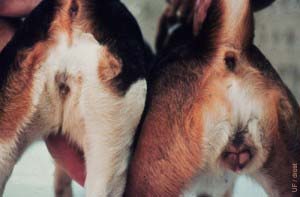
Anestrous bitch (left) and proestrus bitch (right). Photo: tc.umn.edu
It is the point when the discharge becomes watery in appearance that the female is fertile and able to get pregnant.
It is important to know, however, that a male’s sperm can survive for up to a full week in the female’s reproductive system, so it is possible for the female to get pregnant during a wider window than the three to four days of ovulation.
At the end of the heat cycle, the female’s vulva will go back to its normal appearance.
During her heat cycle, a female dog can become pregnant from an encounter with a male dog even without “tying.”
This means that any interaction that results in sperm in the female reproductive tract can result in pregnancy.
“Can I Give My Dog Human Pregnancy Test?”
I've seen this question asked many times on forums and elsewhere by new pet parents.
Many wonders if it's possible to use human pregnancy tests on dogs and whether that would work.
The answer is no; human pregnancy tests do not work on dogs.
Dogs and humans are two different species.
There are ways to tell if your dog is pregnant, but a human pregnancy test will not work on dogs.
“Is there a dog pregnancy test that's an alternative to human ones?”
There are a number of dog pregnancy test kits you can buy online that claim to give accurate results.
Some of the brands you could get on Amazon are:
- Whelply Dog Pregnancy Test for Breeders
- MONGGO Q 10 Pcs Dog Pregnancy Test Kit at Home
- WEEGEEKS Dog Pregnancy Test Kit at Home
These kits claimed they could be used at home, promising owners they could skip the trip to the vet to confirm dog pregnancy.
However, after reading the reviews left by customers, most of them have negative reviews about the process and its accuracy.
Your dog's blood needs to be drawn for these tests. One even requires blood plasma (which can only be extracted with a centrifuge.)
So unless you know how to extract your pet's blood by yourself and you have available lab equipment at home, then these dog pregnancy test kits may not be for you.
And anyway, once you read this whole article, you'll see why having a dog pregnancy test is somewhat unnecessary.
How Long Do Dogs Stay Pregnant (Dog Gestation Period)?
The full length of a female dog’s pregnancy is around 63 days.
During the first few weeks of pregnancy, it is impossible to determine whether the female dog is pregnant.
It's not until the 4th week that a vet may begin to feel the puppies in her uterus, but an ultrasound allows for detecting puppies around 3 days earlier.
While pregnancy may be seen as early as 25 days on an ultrasound reading, it is not until 42 days that the skeletons of the puppies calcify.
Up until this time, pregnancy in dogs cannot be confirmed through an X-ray.
Here is a whelping chart to help you work out the time when to expect puppies:
How Many Puppies Will Your Dog Have
The average litter is between 5 and 6 puppies. However, this can vary significantly.
See below for a week-by-week labor breakdown that will help you predict this better.
The general rule of thumb for litter size is that smaller dogs have a smaller litter size, and larger dogs have a larger litter size.
It's impossible to predict the exact size of litter before the time is right, but the above number is the standard for many canines.
Dog Pregnancy: How to Feed a Pregnant Dog
Figuring out how long dogs stay pregnant is the least of your worries as a pet parent of a pregnant dog.
When caring for a dog during pregnancy, nutrition is particularly important not only for the puppies’ growth but also for the mother dog’s health.
Poor nutrition may lead to severe health problems for the mother dog as well as loss of the litter. It's not unusual for this to happen when delivering puppies.
The specific needs of pregnant canines vary based on the health of every individual dog, but some general guidelines should be followed when feeding pregnant dogs as well as nursing pregnant dogs.
Things to Keep in Mind
- Calories must be increased. The mother must be able to sustain the growth of her puppies as well as provide for her own basic needs, so feed her more dog food that has been specifically formulated for pregnant dogs.
- A high-fat diet is a must. A diet that has more fat in it will help to provide the added calories that a pregnant dog requires. Again, if you choose a special formula, then you don't need to worry about this since it has already been accounted for.
- Multiple small meals. Rather than feeding your pregnant dog 1-2 large meals, stick to feeding her more often higher calorie fatty meals that are also easy to digest. I would recommend discussing a feeding schedule with your veterinarian.
- Phosphorus and calcium should be plentiful. Newborn puppies and pregnant dogs require a specific set of nutrients. Extra calcium and phosphorus allow for healthy bone growth in puppies and healthy milk production in nursing mothers.
- Protein should be increased. Just as they need more calcium, pregnant dogs also need more protein. It facilitates healthy development in future puppies. All dog foods for pregnant dogs have an increased amount of protein already.
- DHA-supplemented food. Same as with humans, DHA (docosahexaenoic acid), which often comes with omega-3 supplements or dog foods fortified with omega-3s, is necessary for the healthy development of the nervous systems of developing puppies.
For a complete week-by-week breakdown of how to feed a pregnant dog, we have written a detailed guide.
Does a Pregnant Dog Need Any Supplements?
In the majority of cases, aside from additional omega-3 fatty acids and EPA/DHA, most pregnant dogs do not require additional pet supplements added to their diet unless they have some specific condition or their dog food doesn't meet their nutritional requirements.
 Only in specific cases are certain supplements given, such as those breeders use to ensure a healthy birthing of puppies.
Only in specific cases are certain supplements given, such as those breeders use to ensure a healthy birthing of puppies.
Revival Animal Health and Nutrition Strength Prenatal Vitamins are two of the most popular supplements given to nursing dogs, but you should not feed this to your pet until your veterinarian has approved them.
Generally, you should also avoid giving a pregnant dog any additional calcium supplements if you're already feeding a special canine formula designed for puppies and pregnant dogs.
Any extra calcium fed to a pregnant dog will cause developmental problems in puppies.
Pregnant dogs should receive adequate nutrition when they are fed a pregnancy or lactating dog food formula, which is exactly what you should be feeding your female canine.
In most cases, you only need dog supplements if making homemade dog food; however, home food is not recommended for a pregnant dog.
When feeding specially formulated pregnant dog food and diets, or best puppy food diets, adding pet supplements when not specifically needed can lead to health problems for the mother dog's health, including pregnancy loss or birth defects in puppies after they're born.
What Is the Best Dog Food for a Pregnant Dog?
When your bitch is pregnant, you should focus on feeding her a very high-quality, well-balanced performance dog food diet or puppy food diet all the way throughout her gestation period.
These dog foods will be designed specifically for puppies' development.
The below commercial dog food for pregnant dogs is very palatable and highly digestible; they also include all the necessary nutrients a pregnant dog and her future newborn puppies will need.
| Preview | Product | Rating | |
|---|---|---|---|

|
Royal Canin Size Health Nutrition Small Mother &... | 1,568 Reviews | Check Price |

|
Hill's Science Diet Dry Dog Food, Puppy, Small... | 6,726 Reviews | Check Price |

|
Diamond Premium Recipe Complete And Balanced Dry... | 6,144 Reviews | Check Price |
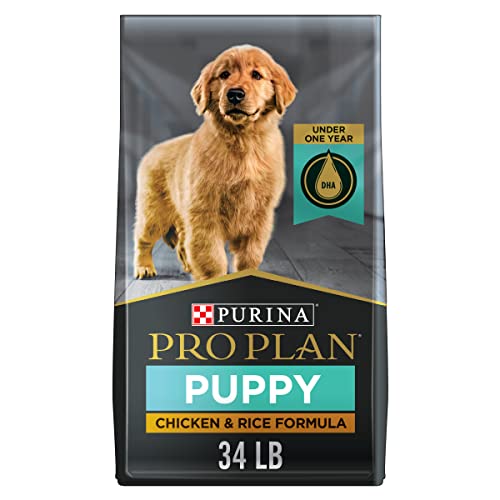
|
Purina Pro Plan High Protein Dry Puppy Food,... | 14,956 Reviews | Check Price |

|
Royal Canin Size Health Nutrition Small Starter... | 1,568 Reviews | Check Price |
It's recommended to keep giving your pregnant dog puppy food all throughout the pregnancy but stop around 7-10 days before delivering the puppies to help with uterus contraction.
Once puppies have been delivered, you can go back to feeding the puppy food again. Ultimately, it's best to discuss a specific diet with your veterinarian.
Dog Pregnancy: Canine Labor
Signs of Labor in Pregnant Dogs
Maintaining a healthy relationship with a veterinarian throughout your dog’s pregnancy will help you track her approximate delivery date.
When you get to around two weeks before that due date, you want to begin taking your dog’s temperature.
You should start by taking a look at the above charts and keeping a record of the pregnant dog's body temperature every day at noon using a lubricated rectal thermometer.
You can use a human thermometer for this (just label it “For Dog”).
A normal temperature for a healthy pregnant dog is between 101 and 102.5 degrees Fahrenheit.
On the day when your pregnant female’s temperature dips to below 100 degrees Fahrenheit, you should expect her to deliver her pups within the next 24 hours.
If, however, you notice that your pregnant female runs a temperature higher than 102.5 degrees Fahrenheit – consult your vet immediately!
A high temperature can indicate infection or other possible complications. Do not wait on this, and at least call your vet.
Preparing for Doggy Labor
When you notice a drop in your pregnant dog's temperature, you want to begin preparing for labor.
This means getting together all the whelping supplies that you will need to help your canine during the puppy delivery process, but only if required.
There are some basics you need, so ensure that you have the following supplies on hand:
- Dental floss
- Clean and sterile scissors
- Clean towels
- A baby suction bulb
I'll explain below why you need these things and how they will be useful.
You also want to ensure that, at this time, your pregnant bitch is in a whelping box, a comfy dog bed, or a confined area lined with clean and sanitary disposable pads or towels.
During the puppy birthing process, you may need to change out these pads or towels, so make sure that you have plenty of them on hand.
Stages of Labor in Dogs
There are three stages of labor in dogs, and every one involves something new.
Your assistance can be helpful to your female dog, but you must know exactly what to do.
1st Stage of Labor
During this first stage of labor, your dog will begin to experience contractions as her cervix begins to dilate.
Just as it is for humans, this is a painful process for the dog, and she will seem restless.
Don't panic, but be aware that that's what is happening.
When your female dog goes through this, it's not uncommon for her to pant, pace, shiver, vomit, whine, or continuously nest during this stage of labor.
The first stage can vary in length – anywhere from six to eighteen hours. And during this time, you should do everything you can to keep the dog calm.
That would be your main priority.
 2nd Stage of Labor
2nd Stage of Labor
During the second stage of labor, contractions get stronger, and your dog will pass fluid that is yellowish in color.
This fluid is the water from the placental sacks.
This begins the process of active labor, and it's important for you to observe this so that you can ensure that the process goes smoothly and with no further complications (see below for that).
Puppies are usually born in intervals of around thirty minutes, with straining preceding each birth.
This is not science, however, and your dog may take longer breaks between delivering each puppy. Now the part that may be grosser comes in.
After each puppy is born, you may notice the expulsion of a placenta. This is normal.
You may also notice that placentas are birthed randomly during the birthing process; this, too, is normal.
When each puppy is born, the mother should lick the puppy roughly to both clean them and bite the umbilical cord.
This process not only “detaches” the puppy but also stimulates him to begin breathing and provides a bonding experience between the mother and pup. There should be no interference on your part.
You should leave the mother to this process but step in if she does not free a puppy from the amniotic sack after some trying.
If this happens, you need to step in and break the sack open. Use your suction bulb to remove fluid from the puppy’s mouth and nose.
You should also use one of your clean towels to rub the puppy vigorously but carefully to stimulate the licking motion of the mother and get him breathing.
You will also want to tie a piece of dental floss around the umbilical cord about an inch from the puppy’s belly and then cut the cord on the side of the dental floss that is furthest from the puppy’s belly.
If it sounds like you should be intimidated by the process – don't be. Read this guide a few times, and if needed, maybe browse through the above-mentioned book.
Once you know what to expect, the process is actually pretty quick and easy to go through.
3rd Stage of Labor
Learning about the time of birth is just as important as learning about how long dogs stay pregnant.
You're not out of the woods just because the puppies are out of the womb.
The third stage of labor takes place when all of the puppies have been born and the mother dog’s uterus contracts completely.
This contraction removes any remaining placenta, fluid, or blood from the uterus.
It can be disconcerting if you are not expecting it, but it is completely normal.
Problems During Dog Pregnancy and Labor
Your research doesn't stop after studying up on what to feed your pregnant dog and the labor process for canines, so here are some pointers in case things go awry with your pregnant dog.
Unfortunately, countless things could go wrong before, during, and after the birth of puppies.
That's why it is best to work closely with a veterinarian during the process. They can keep an eye on your dog and her puppies throughout the gestation period, and they'll be available during the birth if any complications should arise.
However, a vet does not need to be present if you're confident in doing this yourself.
9 Potential Dog Pregnancy Complications
Now, the following are some common complications that you should be aware of.
1. Failure to go into labor
You know how long dogs stay pregnant, but what happens if she hits her due date and doesn't go into labor?
If your dog experiences a drop in body temperature that characteristically precedes labor but does not go into labor within 24 hours, or if it reaches 69 days of pregnancy, consult your vet.
2. Straining during labor
If a laboring mother strains for more than an hour to birth a puppy, it is time to seek help from a veterinarian. You may be able to see the hind legs of the puppy.
If this is the case and you feel confident enough, you can gently aid in pulling the puppy down in a rear arch trajectory yourself. However…
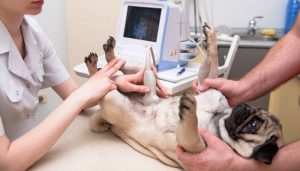 DO NOT pull with any amount of force.
DO NOT pull with any amount of force.
If this does not move the puppy or you cannot see the puppy, it is necessary to call the vet or get your dog to the vet immediately. She may need a C-section.
3. Unborn puppies
If your dog shows no more signs of labor but has not yet passed all of the puppies in her litter, you must consult the vet.
In this situation, your dog may require an IV infusion of oxytocin or a C-section to deliver the rest of the puppies.
4. Eating the afterbirth
After birthing her puppies, the mother dog may eat the afterbirths. This is not unusual.
Eating the placentas may, however, impact how hungry the dog will be later, and it may also impact her bathroom habits.
5. Eating the puppies
In very few cases, particularly if a puppy has a significant defect or if the mother has trouble recognizing her puppy, she may try to eat them.
This does not happen as often as people believe – it's extremely uncommon.
Nevertheless, if you notice her beginning this type of behavior, you should step in and remove the puppy from her grip.
6. Failure to produce milk
In some cases, a mother may not be producing enough milk to nourish her puppies, or she may not be producing any milk at all.
This can happen for a number of reasons, such as disease or mastitis, but when it does happen, the mother and puppies should be taken to the vet immediately.
There's nothing you yourself can do until the vet takes a look.
Basically, these puppies will need to be bottle-fed, and the mother’s underlying health issue needs to be addressed.
Your vet will instruct you on further actions to take.
7. Fever in the mother dog
For a couple of days after giving birth to a litter, a mother dog may have a slight fever.
If that fever reaches any higher than 102.8, it is time to see a veterinarian.
A high fever could be symptomatic of infection or a placenta that has not been expelled, as I have talked about above in this article.
8. Strange behavior from the mother
If a mother dog shows any signs of odd behavior, it is important to get her to the vet immediately.
This can be a symptom of a serious condition known as “milk fever.”
A dog with milk fever may become nervous, seem disoriented, have seizures, have a fever, and even be unable to walk.
You'll be able to recognize that type of behavior easily.
9. Hot, hard, and reddened breasts
Mastitis is not uncommon in mother dogs, and it is characterized by firm, hard breasts that are hot to the touch.
Mastitis is an infection, and when developed, it is painful for the dog as well as dangerous.
Puppies should be hand-fed whenever a mother has mastitis, and the mother should be treated by a veterinarian immediately.
Other Frequently Asked Questions about Dog Pregnancy
What are the first signs of pregnancy in a dog?
There will be telltale signs pretty quickly when a dog is pregnant. Watch out for these symptoms:
- Weight increase without any change in diet
- Your dog's stomach looks noticeably swollen
- Lethargic, not as much energy, gets tired quicker
- Unusually snappy or aggressive toward other dogs or you
- They can also want more attention than normal
- Begin to vomit frequently; this only happens in the first stage of pregnancy
- Not interested in food (first stage of pregnancy) OR they are and want more food than normal
How soon do dogs' nipples enlarge when pregnant?
This happens as the dog gets closer to day 30-40 in the pregnancy. You will notice their nipples will get larger and actually become darker.
Hair loss around the nipple area is also common in long-coat dogs.
What does nesting look like in dogs?
Nesting is common in pregnant dogs. It looks exactly as it sounds.
Your dog will take pillows, blankets, and soft clothes and bring them to a nesting area to prepare a safer environment for the coming dogs.
This usually happens in the first stage of dog pregnancy.
 Dog Pregnancy: Take Home Message
Dog Pregnancy: Take Home Message
Congratulations on making it all the way to this point!
By now, you probably know everything you need to know about dog pregnancy, how long dogs stay pregnant (dog gestation period), how to deliver puppies, and what to feed pregnant dogs during the process.
Pregnancy and the birthing process aren't complicated when you know what to expect and you're prepared with the right type of whelping supplies and dog food for your Fido.
After you help your dog deliver her puppies the first time, if it happens to happen, you're already going to be a pro.
Don't go off trying to start a dog breeding business just yet.
Speaking of which, if you want some helpful and effective tips besides what your veterinarian tells you, I recommend you visit a reputable dog breeder where it's their job to deliver puppies.
Some approved dog breeding businesses do a better job than any veterinarian can.
Talk to the pros, and you'll know everything you need about dog pregnancy, how long dogs are pregnant, and how to help a dog deliver her puppies easily.
READ NEXT: Dog Pregnancy Stages and What to Expect When Expecting
Disclosure: We may earn affiliate commissions at no cost to you from the links on this page. This did not affect our assessment of products. Read more here and find full disclosure here.


